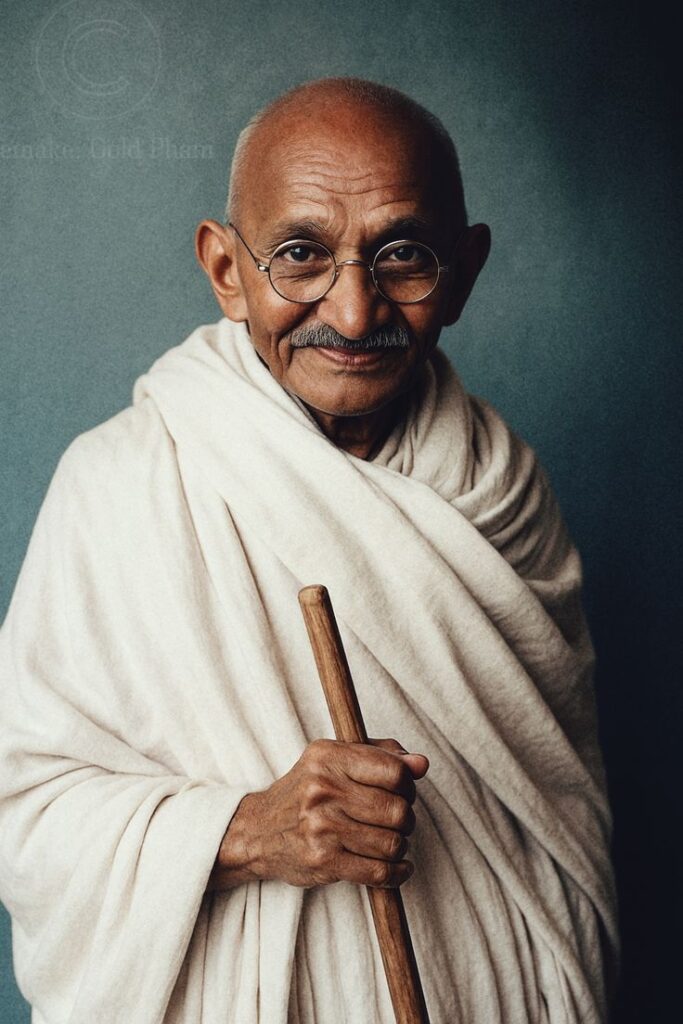
Introduction
Mohandas Karamchand Gandhi, fondly remembered as Mahatma Gandhi or Bapu, was born on October 2, 1869, in Porbandar, Gujarat, India. He is universally recognized as one of the greatest leaders in world history — a man who led India’s struggle for independence not through violence or power, but through truth (Satya) and non-violence (Ahimsa). His philosophy inspired millions across the globe and continues to guide humanity toward peace and justice.
Early Life and Education
Gandhi grew up in a modest household with strong moral values. He went to London to study law at the Inner Temple and later worked in South Africa, where he experienced racial discrimination firsthand. Those experiences awakened in him a deep sense of social justice and laid the foundation for his lifelong mission — to fight oppression through peaceful means.
The Birth of Satyagraha
In South Africa, Gandhi developed the concept of Satyagraha, meaning “truth-force” or “soul-force.” It was a revolutionary idea — resisting evil without violence. Instead of hate, he taught compassion; instead of revenge, he taught forgiveness. This principle became the backbone of his political and spiritual movement.
Role in India’s Freedom Movement
When Gandhi returned to India in 1915, he became a unifying force for the Indian masses. He led several non-violent movements against British rule, including:
- Champaran and Kheda Movements – for farmers’ rights.
- Non-Cooperation Movement (1920) – promoting boycott of British goods.
- Civil Disobedience Movement (1930) – marked by the Salt March, symbolizing the power of peaceful protest.
- Quit India Movement (1942) – a call for immediate independence.
Through these movements, Gandhi transformed India’s struggle for freedom into a moral and spiritual mission.Gandhi’s Core Thoughts and Philosophy
1. Truth (Satya)
For Gandhi, truth was God. He believed that truth must guide every thought, word, and action. To him, truth was not relative — it was absolute, eternal, and divine.
2. Non-Violence (Ahimsa)
Gandhi saw non-violence not as a sign of weakness but as the highest form of strength. It was a powerful weapon that could conquer hate without shedding blood.
3. Simplicity
He lived an extremely simple life — wearing khadi, spinning his own cloth, and rejecting material desires. He believed true happiness comes from simplicity and service.
4. Self-Reliance (Swadeshi)
Gandhi encouraged Indians to be self-reliant, to support local industries, and to promote indigenous goods instead of foreign products.
5. Sarvodaya (Welfare of All)
He envisioned a society based on equality, justice, and compassion — where the upliftment of the poorest was the highest priority.
Gandhi’s Global Influence
Gandhi’s message transcended borders. Leaders like Martin Luther King Jr., Nelson Mandela, and Dalai Lama drew inspiration from his philosophy. His teachings continue to guide movements for civil rights, peace, and environmental sustainability worldwide.
Famous Thoughts of Mahatma Gandhi
“Be the change that you wish to see in the world.”
“The best way to find yourself is to lose yourself in the service of others.”
“An eye for an eye will only make the whole world blind.”
“Where there is love, there is life.”
“The weak can never forgive. Forgiveness is the attribute of the strong.”
Conclusion
Mahatma Gandhi’s life is a timeless example of how one person’s truth and courage can change the destiny of a nation. In an age filled with conflict and division, his message of peace, love, and unity remains more relevant than ever. Gandhi didn’t just fight for India’s freedom — he gave the world a new way to fight injustice.
He proved that real power lies not in weapons, but in the strength of character, truth, and compassion.
